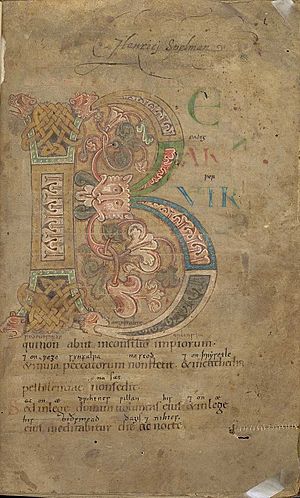Stowe Psalter facts for kids
The Stowe Psalter is a very old book of Psalms from the Anglo-Saxon period. It was made around the years 1050 to 1075. This special book is also known as the Spelman Psalter or King Alfred's Psalter. Today, you can find it at the British Library as Stowe MS 2.
The book contains the Gallican version of the Psalms. These are religious songs and prayers. After the Psalms, there are other religious songs called Canticles. What makes this book extra special is that it has an Old English "gloss" between the lines. A gloss is like a translation or explanation written right above the Latin words. This helped people understand the Latin text better.
Contents
What Is the Stowe Psalter?
The Stowe Psalter is a handwritten book from a long time ago. It is very similar to another old book called the Tiberius Psalter. Both books have the same prayers at the end of each psalm. They also both start with a very large and fancy letter "B" at the beginning of Psalm 1. This special letter is called a Beatus initial. The Old English explanations in the book were written at the same time as the main Latin text.
How Was the Book Made?
The Stowe Psalter has 180 pages, called folios, made from vellum. Vellum is a type of parchment made from animal skin. Each page is about 220 by 180 millimeters, which is roughly the size of a small notebook. The main text is written in an area of 225 by 120 millimeters on each page.
The book was put into a new leather cover in the 1600s. Sadly, two pages at the end of the Canticles section were cut out at some point.
What Does the Writing Look Like?
The main text in the Psalter is written in a style of English handwriting called half-uncials. The titles for each Psalm are written in a different, more decorative style called rustic capitals.
The book doesn't have many big pictures. Its main decorations are three large, fancy letters. The biggest one is the Beatus initial at the start of Psalm 1 (on page 1). There are also smaller decorated letters at the beginning of Psalm 51 (on page 56) and Psalm 101 (on page 111). This style of decoration was common for psalters. Smaller colored letters mark other sections in the text. Later, in the 1400s, some notes and directions were added in the margins.
Where Did the Book Come From?
Experts believe the Stowe Psalter was created at a place called New Minster Abbey in Winchester, England. We know this because the same person who wrote this book also wrote three other manuscripts from New Minster.
Over the centuries, the book had several owners. In the 1500s, someone named "Kateryn Rudston" signed her name on page 9. Later, a famous collector named Sir Henry Spelman owned it. He signed his name on the first and last pages. Sir Henry's son even published a version of the text.
In 1742, the book was sold by Walter Clavell. Then, Thomas Astle owned it and called it King Alfred's Psalter. He even included a copy of one of its pages in his book about writing. The Psalter then became part of the collection of the Duke of Buckingham and Chandos and was kept at Stowe House.
In 1849, the Duke's son sold the book. It was bought by Bertram Ashburnham, 4th Earl of Ashburnham. Finally, in 1883, the British Museum bought the Stowe Psalter, along with many other old books, from the 5th Earl of Ashburnham.
Gallery
See also
- St. Albans Psalter
- Tiberius Psalter




